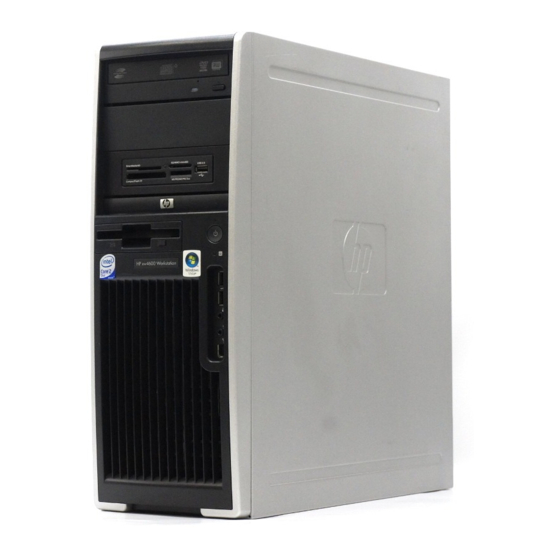
HP Xw4600 - Workstation - 2 GB RAM Installation Manual
Pci express graphics card
Hide thumbs
Also See for Xw4600 - Workstation - 2 GB RAM:
- Technical reference manual (181 pages) ,
- Service and technical reference manual (176 pages) ,
- Specification (73 pages)
Table of Contents
Advertisement
Quick Links
PCI Express graphics card installation
Introduction
This document describes how to install a PCI Express (PCIe) graphics expansion card in the HP Z
and xw Workstation series.
Kit contents
●
Graphics card
●
Graphics driver CD
●
Warranty information
●
Regulatory information
●
Installation instructions
Before you begin
To determine the compatibility of this product with your HP workstation, see QuickSpecs online at
http://www.hp.com/go/productbulletin.
CAUTION:
fan if:
— Your workstation includes dual high-performance* graphics cards.
— Your workstation includes a single high-performance graphics card and an adjacent I/O card that is
located near the inlet of the high-performance graphics card fan.
* Graphics cards with greater than 512 MB of video memory
NOTE:
If installing a secondary graphics card, ensure the cards are compatible.
ENWW
To prevent overheating, your HP xw8400 or xw8600 Workstation might need a front PCI
●
Card guide (for select graphics cards)
●
Support bracket (for select graphics cards)
●
DVI-VGA video cable adapter (for select graphics cards)
●
Display port to DVI cable adapters (for select graphics cards)
●
High-density graphics cable adapter (for select graphics cards)
© 2004–2010 Hewlett-Packard Development Company, L.P. Printed in the
U.S.
Introduction
1
Advertisement
Table of Contents

Summary of Contents for HP Xw4600 - Workstation - 2 GB RAM
-
Page 1: Kit Contents
* Graphics cards with greater than 512 MB of video memory NOTE: If installing a secondary graphics card, ensure the cards are compatible. © 2004–2010 Hewlett-Packard Development Company, L.P. Printed in the U.S. ENWW Introduction... -
Page 2: Warnings And Cautions
Warnings and cautions WARNING! Any surface or area of the equipment marked with this symbol indicates the presence of a hot surface or hot component. If this surface is contacted, the potential for injury exists. To reduce the risk of injury from a hot component, enable the surface to cool before touching. WARNING! Any surface or area of the equipment marked with this symbol indicates the presence of an electrical shock hazard. -
Page 3: Step 1-Preparing For Component Installation
Step 1—Preparing for component installation NOTE: Computer models vary. All illustrations are examples only. Download and install updates Check for available system BIOS updates specified for your HP computer model and operating system at http://www.hp.com/support. Install the system BIOS updates, if available. Accessing the internal components of the computer If you need help preparing the computer for this installation, consult the removal and replacement procedures in the service guide for your computer at... -
Page 4: Step 2-Installing The Graphics Card
Step 2—Installing the graphics card To install the graphics card: NOTE: If the computer has a card guide integrated into the chassis, omit the first step. (Optional) If a card guide was included with the kit, lower it into the chassis and snap it into place. - Page 5 If the graphics card requires additional power, locate the computer auxiliary graphics power supply cable and connect it (3). NOTE: See the service guide to locate the auxiliary graphics power supply cable. Figure 4 Installing the graphics expansion card Reinstall the card support, if removed previously. Otherwise, if the PCIe graphics card has a support bracket, install the support bracket to limit the movement of the card.
-
Page 6: Step 3-Reassembling The Computer
Step 3—Reassembling the computer Reinstall the side access panel. Reconnect power to the computer and all external devices. Restore power to the computer and all external devices. Step 4—Configuring the software After restoring power to the computer, install the graphics drivers from the CD included in the kit. NOTE: At the time of component installation, look for device firmware and driver updates, designated for your computer model and operating system.







